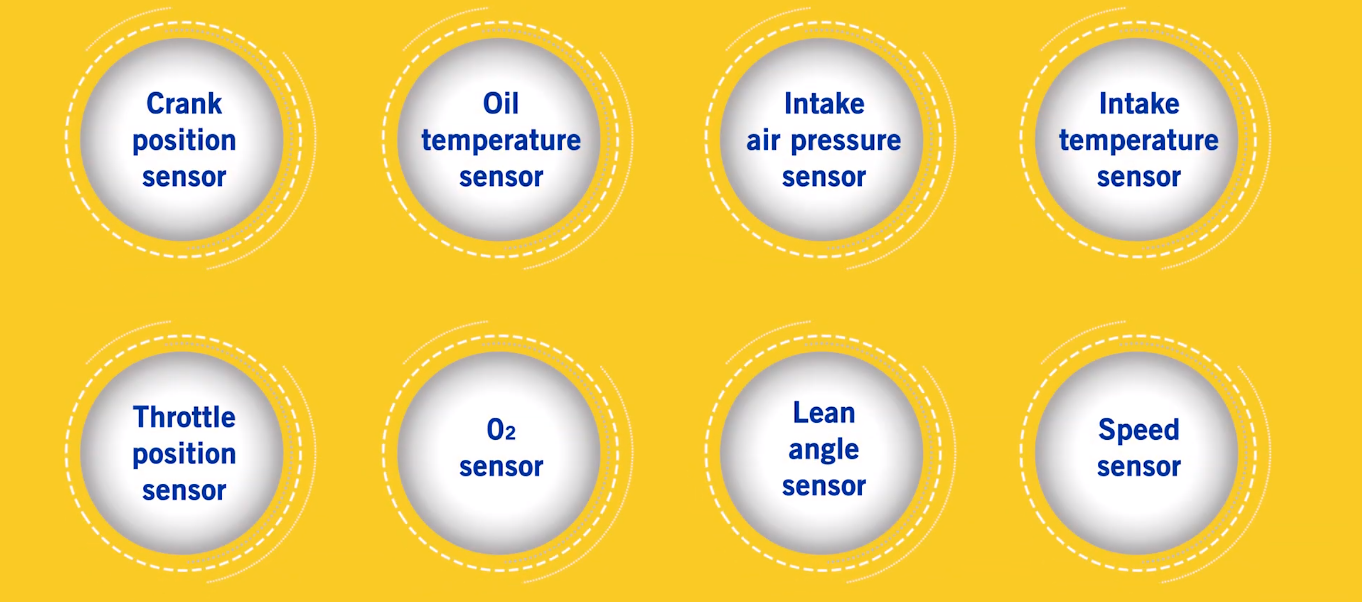Bharat Stage Emission Standards (BSES) are the emission standards instituted by the Government of India. Based on European Emission Standards, it regulates the output of air pollutants from the vehicles along with certain safety standards.
If you didn’t know, the Government of India will start to implement Bharat Stage 6 (BS-VI) starting from April 1, 2020. And, if you were to purchase a new motorcycle, it is very likely that you start to hear the terms like “BS6 complaint engine” and “Fuel Injection”.
Before that happens, let’s get acquainted with the next-gen technology aka the Fuel Injection.

In order to meet the BS VI’s strict standards, the auto brands have to include Fuel Injection engine. Surely, the FI engine is expensive compared to the carburetor. However, the carburetor engine simply isn’t that smart, efficient, nor clean.
Since, Fuel Injection is the only way to achieve a smart, efficient, and clean engine. Different brands like Yamaha, Suzuki, Bajaj, TVS among others were inclined to include FI engines in their future products.
Since everyone is doing it, it has to be good, right? While that might not always be the case, at this instance, it is.
But… why? Why is Fuel Injection a smarter choice? These questions have to be answered!
Sure! This is what we do best! Today, we are going to explain Fuel Injection in more simpler terms.
Fuel Injection System: History
Fuel Injection was started as a concept by Swedish Engineer Jonas Hesselman in 1925. During that time, the technology was strictly developed for Fighter Planes, during World War I.
Interestingly, people tried to implement that technology into small wheelers like cars and motorcycles. Initially, the plan wasn’t as successful as expected. But humans were persistent.
Eventually, they achieve their goals in cars. Finally, after countless research and development, the FI engine was in motorcycles. However, during that time, the price of the FI engine was sky-high. So, it wasn’t realistic to include that kind of expensive engine is lower cc bikes.
But times have changed.
Interestingly, people are more conscious of their carbon footprints. So, a small investment in the FI engine can go a long way for a better tomorrow. Thankfully, the BS-VI standard has made automakers put the nature over cost-saving.

That’s why you’ll a whole lot of motorcycles with the FI engine in Nepal in the coming days. Before that day arrives, let’s get acquainted with the technology.
What is the Fuel Injection System?
You buy a new motorcycle. Then, you head to the nearest petrol pump, feed it into your bike. After that, you enjoy the ride, until you repeat the cycle all over again.
However, people don’t really know exactly what happens behind the scene.
Worry not! That’s why we are here to help!
Starting off, a motorcycle feeds the mixture of fuel and air into the engine. Moreover, the various components inside the engine burn that mixture, which eventually, results in the power and torque.
125cc, 150cc, 250cc, 400cc, etc. is the volume of mixture fed into the engine. So, more volume results in more power and torque. That’s why more ‘cc’ is considered to be performance-oriented.
Typically, motorcycle engines are classified into two types: Carburetor and Fuel Injection.
Both engines do the same thing, burn the fuel and air mixture. However, the working mechanism is totally different.
Carburetor vs Fuel Injection: What’s the Difference?
In the carburetor engine, a finite volume of fuel is sent into the engine. Moreover, the speed of the motorcycle, the environment, and the situation doesn’t really matter. The volume of the mixture is always the same. Plus, there are many working components in this type of system. So, there is always a high chance of error and inefficiency.

If you have a carburetor engine, you might remember pulling the choke, trying your level best to start the engine in an early winter morning. Ironically, that doesn’t always happen in the winter.
If you travel on high altitudes (say Muktinath), there’s a 50% chance that your carburetor bike struggles to perform its level best.
That’s the entire life story of the carburetor engine.
ME: I need more power! I need more torque! I’m stuck in traffic.
Carburetor Engine: Well, I don’t care. Here’s that same volume of fuel. Don’t bother me again.
While the carburetor engines are simple and inexpensive, it comes with a whole lot of headaches in the longer run.
Thankfully, the Fuel Injection System is here to save the day!
In the FI engine, various factors like speed, atmosphere, and situation are taken into account. Depending on those situations, the appropriate amount of fuel mixture is fed into the engine.
Let’s compare the similar situations in which Carburetor humorously fails.
In early winter morning, you don’t have to pull choke! Just turn on the motorcycle, press the start button, done! Likewise, you can travel to the highest point without any worry about struggling performance.
ME: We’re stopping at traffic; I’m going to put it in first gear while pressing the clutch.
FI Engine: I’m going to cut off the fuel right now! Let’s not waste unnecessarily.
Fuel Injection: Learning from the Experts
So far, we’ve established that the FI system is smart. Well, what makes them that smart?
Despite being an auto reviewer, I only knew the basics. But for an article of this caliber, we needed some experts!
We didn’t have to think for long. There was only one expert in the field of Fuel Injection System.
Yamaha.
Yamaha Nepal has been promoting the benefits of the FI engine, longer than its competition. While others were busy refining the carburetor engine, Yamaha had already started to sell motorcycles with excellent FI engines!
With a decade long experience in Fuel Injection engines, we had to approach Yamaha!
Lucky for us, Yamaha Nepal was kind enough to help us.
They welcomed us at their service center at Sitapaila, Kathmandu. Compared to other service centers, it was more of a professional setting, with a separate service station and a unique FI station.

Okay, what’s an FI station?
If you have a Yamaha bike, you might’ve already experienced this first-hand.
Yamaha typically does it at a separate service station. But there’s an extra station: FI Station.
You can give your bike for additional treatment to monitor your FI engine for FREE.
In this station, the Yamaha Diagnostic program is connected from PC to your motorcycle’s FI Engine! Interestingly, there was no need to manually open the engine. All of that was done via cables and connectors.
Anyways, after connecting the motorcycle to the Yamaha computer, the program monitors the engine in REAL-TIME!
You can see everything happen right in front of your eyes. Moreover, your motorcycle gets a detailed look at the engine and its components. At the end of the test, the FI station generates an easy-to-read report after analyzing everything.

If there’s any problem with the FI Engine, you see it without even opening the engine! How cool is that!?!
Plus, there’s an extra perk at the Yamaha’s Fuel Injection station. Upon request, the Fuel Injector can be cleaned in a very interesting way, which you can see it in our Explanation Video.

Well, that was the basic demonstration. Furthermore, the team at Yamaha was kind enough to explain in more detail.
So, the basic working mechanism of the Fuel Injection is based on Yamaha’s FI engine. This is done to get a basic understanding of the concept.
How does a Fuel Injection Engine Work?
We are smart. Likewise, Fuel Injection is also smart.
How are we smart? That’s not really a philosophical question. Just think about a simpler answer.
The brain is what makes us smart. Our sensors relay information to our brain, which in turn, acts on that information.
The same thing can be applied for the Fuel Injection Engine.
There are three major components in an FI system: Sensors, Engine Control Unit (ECU), and Actuator.
Before we jump into details, let’s start with a basic example.
You put your finger on the boiling water. Your skin, which is a sense organ, relay information to your brain that your finger is burning. Upon getting that information, your brain orders your hand to remove that finger from the boiling water.
If I had to connect that example to the components of the FI engine.
- Engine Control Unit = Brain
- Sensors = Skin
- Hand = Actuator
Hopefully, things are getting clearer. With that, let’s jump into details!
ECU in Fuel Injection System
This is what makes the FI system smart! Additionally, the Engine Control Unit (ECU) is also known as the Engine Control Module. Moreover, it is a type of electronic control unit which gathers information from the sensors and based on the info control actuators.
Interestingly, ECU acts as a middle man which ensures optimal engine performance.
Sensors in the Fuel Injection System
In context to Yamaha FI engines, there are about eight different sensors. Furthermore, each sensor is tasked to monitor a specific component in the engine. Again, that information is communicated with ECU.

#1. Crank Position Sensor
This sensor controls the fuel volume as per the engine requirement. So, if the engine wants more fuel, the crank position sensor is stipulated with that specific task to the ECU.
#2. Oil Temperature Sensor
This sensor monitors the engine’s oil/coolant temperature. So, if the oil temperature is at its highest, this sensor notifies the ECU to supply more fuel to prevent any overheating.
#3. Intake Air Pressure Sensor
This sensor monitors the surrounding environment and its air pressure. So, if the bike is at high altitude, it supplies more fuel to the engine for optimal performance.
#4. Intake Temperature Sensor
This sensor allows the motorcycle easy start regardless of any temperature at that time. In the case of a winter morning, the riders can easily start their motorcycles even if it is freezing cold.
#5. Throttle Position Sensor
This sensor monitors the throttle position at the time of the ride. It supplies fuel as per the throttle position. So, if the rider open-throttles at any given time, the sensor notifies ECU to supply more fuel to match the expected performance.
#6. O2 Sensor
This sensor analyzes the different gas levels of the burned fuel mixture. Depending on that data, it maintains fuel efficiency. So, if the burned mixture contains hints of improper burning, the O2 sensor tries to solve that problem.
#7. Lean Angle Sensor
This sensor acts as a safety mechanism. Whenever the bike is titled at an unsafe level, it automatically stops the fuel supply to the engine.
#8. Speed Sensor
This sensor monitors the speed of the motorcycle at any given time. Based on the speed, it tries to improve the fuel efficiency further even if the rider is rough riding or eco-focused.
Actuators in the Fuel Injection System
Those eight sensors generate individual data, which are sent back to the ECU. Based on that information, the ECU assigns the Actuators to perform in such a way that, the motorcycle is efficient at with unwavering performance. So, what does an actuator do? Let’s take a quick look at that!
So, what does an actuator do? Let’s take a quick look at that!
#1. Fast Idle Device
This device allows the motorcycle to maintain idle speed. In turn, it allows the bike to start in any given condition regardless of temperature or altitude.
#2. Injector
This is why the Fuel Injection is known as Fuel Injection. Basically, it feeds a precise volume of fuel into the air, turning it into a mixture. Moreover, the mixture is said to be injected in pressurized form.
#3. Fuel Pump
This is connected to the Injector. Basically, it is tasked to provide fuel supply to the injector.
#4. Ignition Coil
The pressurized mixture of fuel and air to pass into the ignition coil for burning. This process is known as ignition, which is done via the ignition coil.
So, whenever you press the self-start button, these entire components work with one another simultaneously. Interestingly, the entire process is so quick, you don’t really think twice about it.
What are the Benefits of Fuel Injection?
You already know that Fuel Injection engines are more expensive. Typically, people are reluctant to spend more on any product that deprecates like a motorcycle.
To those people out there, let’s take a quick look at the Advantages of a Fuel Injection Engine.
Since this is a detailed article, we’ll also look at the Disadvantages of a Fuel Injection Engine. More on that later. But, let’s take a quick look at the Pros of a Fuel Injection Engine.
Top Performance in Any Condition!
As stated before, the FI Engine can start at any conditions! But that’s not all! The entire system ensures that the motorcycle performs its best as per the rider’s need.
Whether you want a fast performance or quick pickup, the Fuel Injection system guarantees that you get just that!
More Mileage
Fuel Injection gives riders more mileage, especially since, the entire process (the fuel supply, fuel mixture, and fuel-burning) is controlled with strict precision.
In Yamaha’s context, it has been reported that you can get 14% more mileage in the FI engine compared to the carburetor engine.
As an example, let’s look at Yamaha FZ in both FI and Carb version.
If you were to get 40kmpl in the Carburetor engine, you’d get 45.6kmpl in the Fuel-Injection engine. If the total fuel capacity was 10-liters, you would have gotten 400km range in carb version. All the while, you would have gotten a 456km range in the FI version. That’s about 56km difference!
Easy Maintenance
FI Engines come with less moving parts. As seen in the previous example, the FI engine can be monitored without even opening the engine!
All of this adds to easy and affordable maintenance. Honestly, the cost-saving becomes more apparent in the longer run.
Eco-Friendly Engine
Finally, eco-friendly engine. It is a clear fact that the FI engine has lower emissions rates. That’s why it is included in the BS-VI standards.
So, choosing an FI engine over Carburetor one also helps Mother Nature!
What are the Disadvantages of Fuel Injection?
Okay, nobody is perfect. So, does the same apply to the FI system? What are the cons of a fuel injection system?
Hold your horses! I’ll get to that. Honestly, I tried to come up with various different reasons one might want to skip out on Fuel Injection technology. Despite my best efforts, I’m happy to say that there are none.
Everyone has a hater. So, people are bound to come up with a reason not to invest in this engine.
As expected, a hater approached me with just two generic disadvantages: Expensive Repairs and Lack of Reserve Fuel. Kindly, let me debunk that.
Yes, Fuel Injection is expensive to repair when compared to Carburetors. However, the FI engine is built with less moving parts. Moreover, these components are engineered to last longer and withstand more usage. While Fuel Injection Systems are expensive to repair, it is MORE AFFORDABLE THAN A CARBURETOR ENGINE maintenance in a longer run.
Lack of Reserve Fuel? Surely, it is quite convenient to have extra fuel capacity. However. FI systems have one of the most accurate fuel systems.
So, it will notify you whenever you might be running out of fuel with extreme precision. This system is so good, that you don’t need a reserve tank!
Which Fuel Injection Motorcycle Should I Buy?
While staying on topic, you might be asking yourself the very same question.
If you’ve ultimately decided on buying an FI motorcycle, you will not regret this decision. Honestly, coming to realization to buy an FI bike is already smart enough.
However, with BS6 compliant motorcycles coming up, it might be difficult to choose one over another.
In my personal preference, I think Yamaha Bikes is the way to go!
They have much more experience in this field. Interestingly, the competitions are getting on the FI Technology. However, Yamaha has mastered it almost a decade ago.
If you want a safer choice, I’d say, go for Yamaha. However, you are welcome to try different too! Again, if you have decided on an FI engine, that’s already good enough!
-
Realme C63 with 50MP Camera Now Available in NepalHIGHLIGHTS The Realme C63 price in Nepal is Rs. 15,999 (4/128GB). It is powered by…
-
Yamaha MT-15 Version 2.0 Expected to Launch Soon in Nepal: Find Out What’s NewHIGHLIGHTS Yamaha MT 15 V2 price in Nepal is expected to be around Rs. 6…
-
Yamaha Aerox Review: Fast and Fun with R15 at Heart!TechLekh Verdict Yamaha Aerox 155 is an outstanding scooter that combines power, style, and advanced…



























